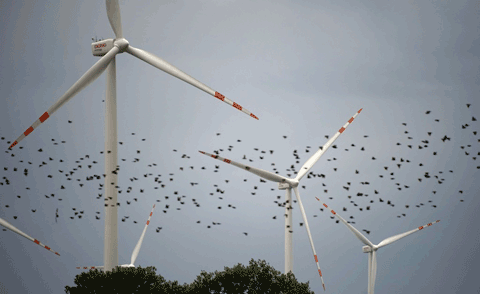David Cassuto (x-post from Animal Blawg)
 Let’s be clear: Our hero favors alternative energy, including wind power. However, nothing is all good and wind turbines kill birds. The U.S. Fish and Wildlife Service estimates that more than 400,000 birds are killed each year by blows from the blades of wind turbines. And as the Department of Energy moves ahead with its (laudable) goal of transitioning the nation’s power supply to 20% wind power, measures must be taken to protect the avians at risk. According to the American Bird Conservancy, the golden eagle, whooping crane, and the greater sage-grouse—face “especially severe” threats from wind energy and are most at risk from “poorly planned and sited wind projects.” The American Wind Energy Association disputes the dimensions of the threat, claiming that “A reasonable, conservative estimate is that of every 10,000 human-related bird deaths in the U.S. today, wind plants cause less than one. The National Academy of Sciences estimated in 2006 that wind energy is responsible for less than 0.003% of (3 of every 100,000) bird deaths caused by human (and feline) activities.”
Let’s be clear: Our hero favors alternative energy, including wind power. However, nothing is all good and wind turbines kill birds. The U.S. Fish and Wildlife Service estimates that more than 400,000 birds are killed each year by blows from the blades of wind turbines. And as the Department of Energy moves ahead with its (laudable) goal of transitioning the nation’s power supply to 20% wind power, measures must be taken to protect the avians at risk. According to the American Bird Conservancy, the golden eagle, whooping crane, and the greater sage-grouse—face “especially severe” threats from wind energy and are most at risk from “poorly planned and sited wind projects.” The American Wind Energy Association disputes the dimensions of the threat, claiming that “A reasonable, conservative estimate is that of every 10,000 human-related bird deaths in the U.S. today, wind plants cause less than one. The National Academy of Sciences estimated in 2006 that wind energy is responsible for less than 0.003% of (3 of every 100,000) bird deaths caused by human (and feline) activities.”
Regardless of who one believes, the new power lines that will inevitably accompany the expansion of wind energy will pose a threat as well. Whooping cranes, for example, migrate over the Great Plains, which is some of the windiest territory in the lower 48. If power lines festoon their stopover sites, then collisions and deaths are inevitable.
Of course, the need to improve the nation’s energy infrastructure and to increase reliance on renewable clean energy are imperatives. The issue is not whether to stop wind energy or upgrade the means of power transmission ; the issue is how to to do it safely and with respect for all those who inhabit the land, water and air.

This is what i don’t like about wind turbines. They kill so many birds. it is hard to tell who is telling the truth about how many are killed by wind turbines. Everyone wants to prove their point.
INDUSTRIAL WIND TURBINES DO NOT PROVIDE GREEN ENERGY AND ARE NOT PART OF A SOLUTION TO GLOBAL WARMING. It’s a case of crony capitalism at its worst. Not one coal or gas plant the world over has been decommissioned because of IWTs…and eliminating our dependence on fossil fuels is their raison d’etre. To quote an expert: “Because wind blows intermittently, electric utilities must either keep their conventional power plants running all the time to make sure the lights don’t go dark, or continually ramp up and down the output from conventional coal-or gas-fired generators (called “cycling”). But coal-fired and gas-fired generators are designed to run continuously, and if they don’t, fuel consumption and emissions generally increase.” This is happening the world over – CO2 and power plant pollution have increased since they installed wind farms, and in Britain the technology has failed.
1) http://www.denverpost.com/headlines/ci_15081808
2) http://www.energytribune.com/articles.cfm/6310/Britains-Wind-Farms-are-No-Spin-Zones-When-Cold-Hits